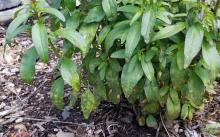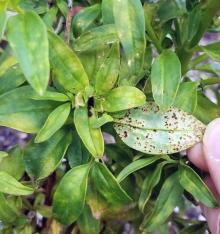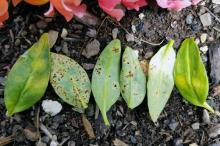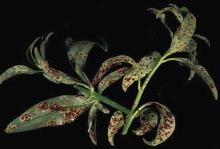Cause Puccinia antirrhini, a fungus carried in diseased cuttings or spread by wind-blown rain, splashing water or clothes. Spores can also be spread by wind over long distances. Two races of the fungus have been identified. It is not carried in seed but may contaminate seed or seed pods. Plants must be wet 6 to 8 hours for infection to occur. The disease is favored by 55°F to 70°F temperatures but inhibited by temperatures above 80°F. Earwigs eat pustules and spores from their feces are not viable. The disease is commonly observed on plants that survive winter conditions to grow another season.
Symptoms Initial symptoms on leave are small, chlorotic swellings that increase in size until the epidermis ruptures. Upper leaf surfaces have diffuse pale or yellow spots. Under the leaf where the epidermis ruptured are concentric rings of chocolate-brown pustules (uredinia and telia). One or two concentric rings of small secondary pustules for around the original pustule. Pustules are also on stems and flowers, which are initially small, elongate, and causing a swollen canker. The whole plant may look stunted and dry. Flowers may open prematurely and are smaller than normal. Pycnia and aecia are unknown. Telia form late in the season.
Cultural control
- Start plants from seed.
- If using cuttings, make sure they are from pathogen-free plants.
- There are differences in cultivar reaction so select ones that are more resistant.
- Allow good air drainage between plants.
- Avoid overhead irrigation, or water such that plants are not wet for extended periods of time.
- Keep the greenhouse above 70°F for several days and not below 60°F at night.
Chemical control Focus on cultural controls for best results.
- Armada 50 WDG at 3 to 9 oz/100 gal water. Do not use a silicone-based surfactant. Not for nursery or greenhouse use. Group 3 + 11 fungicide. 12-hr reentry.
- Banner MAXX at 5 to 8 fl oz/100 gal water. Group 3 fungicide. 12-hr reentry.
- Avelyo at 3 to 5 fl oz/100 gal water. Group 3 fungicide. 12-hr reentry.
- Broadform at 4 to 8 fl oz/100 gal water. Group 7 + 11 fungicide. 12-hr reentry.
- Compass 50 WDG at 2 to 4 oz/100 gal water plus an adjuvant. Do not use organosilicate additives. Group 11 fungicide. 12-hr reentry.
- Eagle 20 EW at 6 to 12 fl oz/100 gal water. Group 3 fungicide. 24-hr reentry.
- EcoSwing at 2.5 to 3.2 oz/10 gal water. Group BM01 fungicide. 4-hr reentry. O
- Ferti-lome Liquid Systemic Fungicide II at 1 fl oz/gal water. H
- Heritage at 0.5 to 2 oz/100 gal water plus a non-silicone-based wetter sticker. Group 11 fungicide. 4-hr reentry.
- Infuse Systemic Disease Control at 2 Tbsp/gal water. Group 3 fungicide. H
- Mancozeb-based products. Group M3 fungicides. 24-hr reentry.
- Fore 80 WP at 1.5 lb/100 gal water plus a spreader-sticker.
- Protect DF at 1 to 2 lb/100 gal water plus 2 to 4 oz spreader-sticker.
- Mural at 4 to 7 oz/100 gal water. Group 7 + 11 fungicide. 12-hr reentry.
- Myclobutanil 20 EW T&O at 6 to 12 fl oz/100 gal water plus spreading agent. May observe a PGR effect. Group 3 fungicide. 24-hr reentry.
- Orkestra at 6 to 8 fl oz/100 gal water. Group 7 + 11 fungicide. 12-hr reentry.
- Ortho Rose & Flower Disease Control at 2 fl oz/gal water. Group 3 fungicide. H
- Pageant at 12 to 18 oz/100 gal water. Do not use with organosilicone-based adjuvants. Group 7 + 11 fungicide. 12-hr reentry.
- Postiva at 10 to 28 fl oz/100 gal water. Group 3 + 7 fungicide. 12-hr reentry.
- ProStar 70 WG at 3 to 6 oz/100 gal water. Group 7 fungicide. 12-hr reentry.
- Spectracide Immunox Multi-Purpose Fungicide Spray Concentrate for Gardens at 1 fl oz/gal water. Group 3 fungicide. H
- Terraguard SC at 2 to 8 fl oz/100 gal water. Group 3 fungicide. 12-hr reentry.
- Tourney EZ at 1 to 4 oz/100 gal water. Group 3 fungicide. 12-hr reentry.
- Ziram 76 DF at 1.5 to 2 lb/100 gal water. Group M3 fungicide. 48-hr reentry.
Note: Products that contain the group 11 fungicide azoxystrobin, such as Heritage and Mural, should be avoided due to phytotoxicity. Injury of certain cultivars may occur with repeated use.
Biological control
- AmyloShield (Bacillus amyloliquefaciens strain PTA-4838) at 1.5 to 3.5 lb/A outdoor or 0.6 to 1.2 oz/gal in the greenhouse. Group BM02 fungicide. 12-hr reentry. O
- Cease or Rhapsody (Bacillus subtilis strain QST 713) at 2 to 8 quarts/100 gal water. Active ingredient is a small protein. Was somewhat effective. 4-hr reentry. O
References Aitken, E.A.B., Newbury, H.J., and Callow, J.A. 1989. Races of rust (Puccinia antirrhini) of Antirrhinum majus and the inheritance of host resistance. Plant Pathology 38:169-175.
Wegulo, S.N., and Chase, A.R. 2017. Diseases of Snapdragon. In McGovern, R.J., and Elmer, W.H. (eds.) Handbook of Florists' Crops Diseases. Springer Int.




